 By Margo Kirchner The mother of a man killed by police after she called to ask for a wellness check on her mentally ill son put it bluntly: “How could you as a parent not blame yourself for that phone call?” Toni Biegert's son Joseph was shot by police in 2015. She and others — family members of nine men killed by officers — testified recently before a subcommittee of the Assembly Speaker’s Task Force on Racial Disparities. The committee wanted specifically to hear from families impacted by disparities in law enforcement. Joseph suffered from depression, and after Toni spoke with him by telephone that day in 2015 she worried that he would take too much medication, as he had threatened that previously. Toni said she could not get across Green Bay fast enough to get to Joseph herself. When police arrived, Joseph, age 30, let them in and was cooperative, Toni said. Police checked for weapons but found none, she stated. The officers decided to take Joseph into custody and when they patted down his pelvic area he reacted and pulled away. The scene then became chaotic, said Toni. Police took Joseph to the ground, punched him, and hit him with a baton. Toni said the police version of the scene includes Joseph dragging officers to the kitchen, where he obtained a knife from a butcher block and grazed an officer’s arm with it. Police then shot Joseph nine times. Toni said she will never know the facts, emphasizing that “Joseph’s not here to tell his side of the story.” Toni testified that her life will never be the same. She asked subcommittee members to put themselves in her shoes as the parent who reached out “to have someone just check on your child and he’s dead now.” She questioned why police would take her son down and punch him merely because he pulled back when touched. In her opinion they should have calmed him down. Joe’s only crime was that he suffered from mental illness, she said. Toni called for mandatory crisis intervention training, or “CIT,” for every police officer, because one in five people suffers from mental illness. She charged that the officers who shot her son escalated the situation from the beginning of the encounter and that CIT could have affected the outcome. Toni indicated that in response to her demands for mandatory CIT she has been told that no funding exists for it, and CIT remains a voluntary program. She questioned why CIT and compassion are not part of police academy training. “Police officers need to know how to interact with people who are suffering” with mental illness, she said. “At the end of the day, my son shouldn’t be dead,” she said.
0 Comments
 By Gretchen Schuldt Complying with a federal court settlement to end race-based stops by Milwaukee police "seems an afterthought" to many city officials, including those at the top, according to the settlement monitor. "It is not integrated into the daily work, strategic planning, and service to the community for all of government," the monitor, the Crime and Justice Institute, said in its second annual report on the settlement. "Dedicated professionals" are seeking to implement the settlement, "and yet, they seem to toil without a citywide mandate or the highest-level leadership confirming that this work matters," the report said. "Up to this point," the report said, "we have not seen any leader organize all relevant agencies in a conversation that drives the Defendants toward compliance. Each agency seems left to its own to set a plan without oversight, coordination, or direction." "They seem to toil without a citywide mandate or the highest-level leadership confirming that this work matters." Neither Mayor Tom Barrett nor Common Council President Cavalier Johnson responded to requests for comment on the consultant's findings. "Unfortunately, too few seem focused on the path of hard work towards compliance," CJI said.. "Or even on the important, long-term reforms that compliance permits." Police traffic and pedestrian stops still show evidence of bias, CJI said, and the city remains out of compliance with many terms of the 2018 settlement. The settlement followed a federal court lawsuit filed by the ACLU of Wisconsin, the national ACLU and the law firm of Covington and Burling. The Police Department, the Fire and Police Commission, and the city agreed to undertake a number of reforms, including an end to race-based pedestrian and traffic stops. "Many reforms embedded in the agreement require substantial government involvement, following the notion that creating and living in a safe community should not just concern the public and police...." the report said. "Effective oversight is a responsibility of and should be a concern for all aspects of government." "Each agency seems left to its own to set a plan without oversight, coordination, or direction." The city's financial concerns may lead it to underfund compliance efforts.
"Achieving the reforms set forth by the settlement agreement, to which the defendants agreed, comes with some costs," the report said. Sufficient staffing, for example, is necessary, it said. Barrett has proposed a $300,000 budget for settlement implementation in 2021, the same amount as this year. The report said bluntly that Barrett and the Common Council should appoint new Fire and Police Commission members to fill two vacancies and the seat held by a commissioner whose term has expired. Commission members are appointed by the mayor and confirmed by the council. "The vacancies limit the roles for interested community members, and consequently also limit points of access for the community," the report said. "There are likely many qualified individuals in the city who would be interested in serving, so it is unclear why the vacancies remain....The settlement agreement envisions a more robust and effective FPC and the demands on the FPC will only expand with the work toward compliance." "It is imperative that the Mayor and Common Council act to fill these vacant positions," the report said.  Wanggaard Wanggaard By Gretchen Schuldt Municipalities would be required to maintain police funding at current levels or lose state aid, under a package of police-related bills to be introduced by Sen. Van Wanggaard (R-Racine). The requirement would have a devastating impact on local governments that are under enormous economic stress because of revenue lost during the coronavirus pandemic. Gov. Tony Evers called the Legislature into session on Monday to consider his nine-bill police reform package. Wanggard responded Thursday by announcing eight police-related bills of his own. State Sen. Alberta Darling (R-River Hills) is a co-sponsor on all eight bills and Rep. Janel Brandtjen, (R-Menomonee Falls) is a co-sponsor of a bill dealing with the make-up and operation of Milwaukee and Madison fire and police commissions, according to the Racine County Eye. Below are the Legislative Reference Bureau's summaries of the Wanggaard bills. Bill 1: This bill creates an independent use of force review advisory board. Under the bill, the board conducts independent investigations of deaths and serious injuries to law enforcement officers and deaths and serious injuries to others resulting from an action or omission of a law enforcement officer. The board must recommend measures to reduce the probabilities of deaths and serious injuries from similar causes and must also review its previous recommendations to determine if they were implemented and evaluate their effectiveness. Under the bill, if the board conducts an investigation of an incident involving an officer that resulted in death or a serious injury, its investigation may begin only after any mandatory or criminal investigation concludes. The bill grants the board access to all complete criminal and administrative investigation case files, models or renderings used in an investigation, and evidence and also to the state crime laboratories. The board must acquire experts and use advisors as needed to perform its duties; the experts and advisors include a certified firearms instructor, a defensive and arrest tactics instructor, an expert in cultural competency, a master instructor in professional communications, a master instructor in tactical response, a victim advocate, and a mental health professional. When the board completes an investigation, it must prepare an advisory report to be made public and be submitted to the legislature, all law enforcement agencies, and the Law Enforcement Standards Board. The report must identify events or developments that led to the officer-involved death or serious injury and make recommendations to prevent similar incidents in the future. The report must provide demographic information about each incident, share best practices used by law enforcement officers, and recommend practices that the board learns when exercising its review. Note: The makeup of the board would be heavily weighted toward law enforcement and police unions. According to the bill, the board would include
Bill 2: Current law requires each law enforcement agency to have a publicly available policy or standard regulating the use of force by law enforcement officers. This bill requires each such policy or standard to provide the instances in which a use of force must be reported, how to report a use of force, and a requirement that officers who engage in or observe a reportable use of force must report it. This bill also prohibits disciplining a law enforcement officer for reporting a violation of an agency's policy or standard regarding the use of force. Bill 3: Current law requires each law enforcement agency to prepare a policy regarding the use of force by its law enforcement officers and to make the policy available for public scrutiny. This bill requires the law enforcement agency to post its policy on the law enforcement agency website or, if the agency does not have one, on a site maintained by the municipality over which the law enforcement agency has jurisdiction. Under the bill, if the policy is changed, the law enforcement agency must ensure that the updated policy is posted as soon as practically possible but no later than one year after the change is made. The bill also requires a law enforcement agency to prominently post a means to request a copy of the policy and to provide a copy of the current policy at no charge as soon as practically possible but no later than three business days after a request is made. Bill 4: This bill makes a number of changes that affect the board of fire and police commissioners of a 1st class city (presently only Milwaukee), the board of police and fire commissioners of a 2nd class city with a population of 200,000 or more (presently only Madison) (jointly referred to as affected PFC boards), and the protective services departments of 1st class cities and 2nd class cities with a population of 200,000 or more (jointly, populous cities). The changes include altering the makeup of affected PFC boards, requiring certain training for affected PFC board members, establishing certain requirements related to hiring and oversight of chiefs of protective services departments in populous cities, creating an executive director or independent monitor position in populous cities, and altering the judicial review process for police and fire department disciplinary cases in a 1st class city. Under current law, the board of fire and police commissioners of a 1st class city consists of seven or nine members selected by the mayor. Boards of police and fire commissioners of other cities, including a 2nd class city, consist of five members selected by the mayor. Under this bill, a board of fire and police commissioners of a 1st class city consists of nine members selected by the mayor, and confirmed by the common council. The board of a police and fire commission of a 2nd class city with a population of 200,000 or more consists of seven members selected by the mayor. Each of these boards must contain at least one member selected from a list provided by each of 1) the employee association that represents nonsupervisory law enforcement officers and 2) the employee association that represents fire fighters. This bill provides a method for selecting members of affected PFC boards when the mayor fails to make an appointment to a vacant position. If the mayor fails to make an appointment within 120 days of the occurrence of a vacancy, the common council may make the appointment, except when the vacant position is one that must be filled from one of the lists described above. In this case, the association that provided the list may make the appointment without confirmation by the common council. In a 1st class city, a three-member panel of the board of fire and police commissioners may conduct and decide a trial to evaluate a complaint against a member of the police or fire department. This bill specifies that when a three-member panel conducts such a trial, at least one member of the panel must have professional law enforcement experience if the accused is a police officer, and at least one such member must have professional fire fighting experience if the accused is a fire fighter. The bill also requires each member of an affected PFC board to take a training class provided by the city in which it operates. The training class must cover the mission and role of the board, the procedures that apply to disciplinary hearings, the conduct policies of the police and fire departments, and use of force guidelines of the police department. A member may not participate in any action of the board until he or she completes the training class and any other training required by the city. The bill also creates the office of executive director in a 1st class city and the office of independent monitor in a 2nd class city with a population of 200,000 or more. Despite the different titles, these positions have the same duties and requirements. This person acts as the principal staff of an affected PFC board, reviews certain situations or investigations involving the police or fire department, evaluates police and fire department policies and practices, and issues periodic reports to the public relating to the status and outcome of complaints that have been filed. The executive director or independent monitor is appointed by the mayor and confirmed by the common council and serves a four-year term, at the pleasure of the board. This bill also specifies the following related to affected PFC boards: 1. When an affected PFC board appoints a protective services chief, the board must meet in closed session with representatives of the employee association whose members will serve under the proposed chief. 2. When an affected PFC board appoints a protective services chief, the board must hold at least two public meetings to hear comments from residents of the city and other interested persons. 3. When a member is appointed to an affected PFC board, the common council must hold two public hearings that include public comment periods with regard to the appointments. 4. If an affected PFC board accepts an additional application for chief of police after the application period for accepting these applications has closed, the board must reopen the application period for an additional seven days. 5. If the common council adopts a resolution by a two-thirds majority to conduct a performance review of a protective services chief, an affected PFC board must conduct the review and provide a written report to the common council. 6. A PFC board member may not continue in office after the expiration of his or her term, unless reappointed and, in a 1st class city, confirmed. Currently, if a board of fire and police commissioners of a 1st class city discharges, suspends, or reduces in rank an officer or member of the police or fire department, the disciplined person may appeal that decision to a circuit court. This bill specifies the scope of review under which a court is to review an appeal of this sort. Under the bill, a court must review the evidence independently and without deference to the board's findings; must reverse the board's decision if it finds that fairness or correctness of the action has been impaired by material or procedural errors; and must set aside or modify the board's decision if it finds that the board erroneously interpreted a provision of law, or may remand the case to the board for further action that is consistent with current law. The bill also requires the court to reverse the board's decision if it finds that the board's exercise of discretion is outside of its delegated powers; is inconsistent with a board rule, policy, or practice, unless the board's deviation is adequately explained; or violates the constitution or the statutes. The bill also authorizes a court to take additional testimony, depositions, and interrogatories, and to grant requests for additional discovery. Bill 5: This bill establishes a $600,000 grant program, administered by the Department of Justice, for cities with a population of 60,000 or more to fund community-oriented policing house programs. Bill 6: Under this bill, if in any year a municipality decreases the amount of its municipal budget dedicated to hiring, training, and retaining law enforcement officers so that it is less than the amount dedicated to that purpose in the previous year, the municipality will receive a county and municipal aid payment that is reduced by the amount of that decrease. The bill provides that the amount of all such reductions will be distributed to the municipalities that did not reduce their law enforcement budgets in proportion to each municipality's share of the total amount of county and municipal aid payments. Furthermore, the amount of the reduced payment that the municipality receives becomes the amount of county and municipal aid that the municipality will receive in subsequent years. The reductions under the bill do not apply to a municipality that transfers responsibility for providing law enforcement to another local unit of government or that enters into a cooperative agreement to share law enforcement responsibilities with another local unit of government. Bill 7: Current law requires law enforcement agencies to develop policies on the use of force by law enforcement officers in the performance of their duties. This bill provides that a law enforcement agency may not authorize in its use of force policy the use of choke holds by law enforcement officers, except in life threatening situations or in self-defense. Bill 8: Current law requires the Department of Justice to collect certain information concerning criminal offenses committed in Wisconsin. This bill requires DOJ to collect data and publish an annual report on law enforcement use of force incidents, including incidents where there was a shooting, where a firearm was discharged in the direction of a person (even if there was no injury), and where other serious bodily harm resulted from the incident. The bill requires certain demographic information to be collected about each such incident, and reported annually by DOJ on its Internet site.
 By Gretchen Schuldt The Milwaukee Police Department absorbed 62 cents of every new dollar that went toward city departments' operating budgets over the last decade, budget figures show. That left just 38 cents per dollar to split among the 18 other city departments, including the Health Department, the Milwaukee Public Library, the Department of Neighborhood Services, the Fire Department, and the Department of Public Works. "We are looking at how we staff the Police Department and what they respond to....We're going to have to rethink a lot of things," said Dennis Yaccarino, city budget and management director. The Police Department's operating budget increased by $80.5 million, from $216.8 million to $297.4 million, from 2010 to 2020. The 18 remaining departments received combined general budget increases of $48.9 million from 2010 to 2020. All departmental budgets rose $129.4 million over that time, from $527.8 million to $657.2 million. The number of authorized Police Department full-time positions funded through the general budget fell slightly, by 60, from 2,687 to 2,627, over the 10 years, while the number of positions in the other departments fell from 3,117 to 3,103, a decline of 14, according to budget documents. Police Department spending is sure to be a contentious topic during the Common Council debate over the 2021 city budget. Activists want to cut up to $75 million from the police budget in 2021 and allocate the amount to other purposes. The council has suggested a 10% trim for the Police Department. The city's revenue picture has been upended by the coronavirus crisis. Meanwhile, protesters and others have demanded, since the death of George Floyd in May, changes in policing practices.
The city will renew its efforts for an increased sales tax that could be used to help out the city budget, Yaccarino said. The city this year will publicly discuss budget initiatives – including those involving the police – before Mayor Tom Barrett's proposed budget is released in September, Yaccarino said. City officials are working to increase both public understanding of budget issues and input into the process, he said. The city is seeking input through a budget survey and has posted a tool that allows residents to build their own budget. Both are here.  Murphy Murphy By Gretchen Schuldt Any significant budget cuts to the Milwaukee Police Department will affect staff and could well result in disproportionate cuts in the number of officers of color on the force, city figures show. "I don't have a magic wand to change that," said Ald. Michael Murphy, chair of the Common Council's Finance and Personnel Committee. About 95% of the department's operating budget this year, or $281.4 million of $297.4 million, is devoted to wages and fringe benefits, so any significant budget cut would have to include cuts in staffing. The city's contract with the police union calls for the most recent hires to be the first to lose their jobs when and if the cuts come. If officers are hired at the same time – and officers in the same academy graduating class are considered to have the same seniority date – then their placement on the eligibility list at the time of hire is the tiebreaker, said city Labor Negotiator Nicole Fleck. Most officers of color are bunched at the low end of the seniority scale, as the chart below shows. There are fewer people of color who become officers in the first place and they leave the job at faster rates than whites. While there are 112 African-American police officers with fewer than five years' experience, there are just 20 with six to 10 years' service, and 34 with 11 to 15 years on the job. There are 92 Hispanic officers with fewer than five years' experience, but just 31 with six to 10 years on the job and 34 with 10 to 15 years. White officers also leave, but at lower rates, which adds to their edge in seniority. There are 271 White officers with fewer than five years' experience, 154 with six to 10 years', and 169 with 11 to 15 years of service. Whites account for 55% of officers with fewer than five years on the job, but that jumps to 72% of those with six to 10 years of service and 68% of officers with 11 to 15 years on the force. The city eliminated 60 police officer positions this year through attrition, Murphy said, and the financial situation looks worse for next year. City revenue is taking a hit because the coronavirus crisis is affecting tax collections at both the city and state levels.
The Common Council has indicated it will consider a police budget cut of 10%, or roughly $30 million. Police Chief Alfonso Morales, in a Milwaukee Journal Sentinel op-ed, said that would mean about 375 lost officer jobs. Activists are seeking a $75 million cut and want the money to go to other services. The Police Department has asked for an $18.5 million budget increase, according to budget documents. A $75 million cut, Murphy said, would mean about half the force would go. "It's the way it is," he said. Markasa Tucker, director of the African American Round Table, a driving force behind the request for cuts, did not respond to a request for comment. Neither did Common Council President Cavalier Johnson. Officers of color would likely be hit disproportionately, and that would not be good for the city. Its police, Murphy said, "should reflect the community." The city does not have many options, he said. "I don't know how to do it otherwise with the current (contract) restrictions in place," he said. By Margo Kirchner Criminal law rarely provides justice in cases of police brutality and violence because convictions are so difficult to obtain even with video evidence, according to a Villanova University law school associate dean. “It’s hard to win cases against police officers, and because plaintiffs usually lose, police are not deterred from their bad behavior,” said Teressa Ravenell, who also is a professor at Villanova’s Charles Widger School of Law. Ravenell made her comments during the American Constitution Society’s recent briefing call on police violence and systematic racism in the U.S. legal system. ACS held the call in response to the killing of George Floyd and waves of protest across the country. Ravenell said that federal law allows individuals to sue when their civil rights are violated by government actors, but that law has not prevented police violence either. The law, Section 1983, has become “another example of systematic failure,” she remarked. The statute is “not inherently flawed,” but the U.S. Supreme Court’s interpretation of the statute has caused it to fail, she said. Problematic interpretation of Section 1983 includes the judge-made doctrine of qualified immunity, Ravenell said. The qualified immunity doctrine protects public officials from civil liability unless their conduct violates a clearly established constitutional right about which a reasonable person would have known. The Supreme Court has written that the doctrine protects "all but the plainly incompetent or those who knowingly violate the law” and balances the need to hold public officials accountable when they act irresponsibly with the need to shield them from harassment, distraction, and liability when they perform their duties reasonably.
In a 2018 dissent, however, Justice Sonia Sotomayor wrote that the doctrine “tells officers that they can shoot first and think later, and it tells the public that palpably unreasonable conduct will go unpunished.” The doctrine has recently shielded officers from liability for stealing $225,000 while executing a search warrant, shooting a 10-year-old boy in his backyard while pursuing a suspect, and slamming to the ground a woman who turned to walk away from an officer toward her daughter, rendering the woman unconscious. Ravenell set forth five large hurdles plaintiffs face under current law, which in her view result in continued racist law enforcement. First, the Supreme Court’s Fourth Amendment cases give police officers too much power to stop, investigate, and arrest Black people. Police may legally stop someone if an officer has reasonable suspicion to think that criminal activity is afoot, and that standard can be met when a person acts evasively in a high-crime area. Ravenell called “high-crime area” a “fancy way” of saying poor, Black neighborhoods. As a result, Blacks are more likely to be stopped by police. Further, Blacks are pulled over for traffic violations more than any other group, she said. Second, the Court’s Fourth Amendment cases give police officers too much license to use force. The court has allowed officers to use deadly force when they reasonably believe a person poses an immediate threat of harm to the officer or others, and too often officers view unarmed Black men as threats, Ravenell said. Ravenell proposed that the qualified immunity standard should at the least be transformed from considering what a reasonable or average officer would do to what a well-trained officer would do in the situation. Third, Ravenell said, under current law plaintiffs face too many causation problems because they must establish which specific officers harmed them. For instance, a protester shot by a rubber bullet must show which officer fired the shot. But that is impossible if officers will not testify against each other, she remarked. Fourth, the qualified immunity defense protects officers in too many situations when the law was not clearly established at the time the officers acted. “Many people are writing about this right now,” she said, adding that “we need to eliminate the qualified immunity defense.” Fifth, even when plaintiffs succeed, verdicts against officers fail to alter conduct because officers do not pay the verdicts against them; taxpayers do. Ravenell closed by noting that the failure to fire violent officers also played a role in creating the current crisis. The officer who killed George Floyd had 18 prior complaints against him, she noted. Ravenell compared the vastly greater money spent on monitoring parolees with that spent on monitoring police. “We need to ensure that police departments have the incentive and the means to terminate the recidivist officers,” plus a database to track them so they are not hired by other communities, she said. Another call participant, Taja-Nia Henderson, a professor at Rutgers Law School and dean of the Rutgers Graduate School, discussed the historical predicates for police abuses today. Henderson described how policing in the United States has always been linked to property interests and the control of black and brown bodies.  sBy Gretchen Schuldt The Milwaukee Police Department's use-of-force policy does not prohibit the chokeholds or the kind of restraint that Minneapolis police used when they killed George Floyd, records show. Milwaukee has adopted just three of eight restriction on use of force recommended by Campaign Zero, an effort to reduce killings by police, according to the campaign. Fire and Police Commission Executive Director Griselda Aldrete, responding to recent protests in Milwaukee, told the Common Council's Public Safety and Health Committee last week that the commission will review the policy. Milwaukee's use-of-force policy also keeps secret the some of the weapons that the Police Department can use against protesters and others. The policy does not disclose why the public should not know what can of weapons can be turned against it. The policy says the secret weapons are not lethal, but that cannot be verified without knowing what they are. Tear gas and rubber bullets also have been described as nonlethal, but they can kill or maim. Campaign Zero has identified eight restrictions associated with fewer killings by police. Of those, eight, Milwaukee has adopted three – establishing a continuum of force, requiring a warning before shooting, and imposing on officers a duty to intervene if they see an excessive use of force by a colleague. The campaign also says the city does not require that all other alternatives be exhausted before officers are authorized to shoot, but the Fire and Police Commission last year approved language that says that use of force that may result in serious injury or death "may only be used as a last resort." The other recommended restrictions the city has not adopted, according to the campaign, include:
While the city's policy does require reporting of many types of uses of force, it does not require reporting when an officer points a gun at someone without firing, according to the campaign. The campaign reported in 2016 that each of the eight recommended killings were associated with fewer police-involved killings. The policies linked to the largest drops in police-involved deaths were required comprehensive reporting (25% reduction), the requirment that officers to exhaust all other reasonable means before shooting (25% reduction), and that ban on chokeholds and strangleholds (22% reduction). "While each individual policy predicted lower rates of police-involved killings, the fewest killings per population were observed among police departments that had several of these policies in place," the study said. "For example, departments with four or more of restrictive use of force policies in place had 37% fewer police-involved killings per population than those that had 0 or 1 of these policies in place." Milwaukee Police attribute traffic ticket drop to stop-and-frisk lawsuit settlement with ACLU11/14/2019  Morales Morales By Gretchen Schuldt Milwaukee police officials during budget hearings attributed the decline in city traffic citations this year to the city's settlement in the ACLU's stop-and-frisk lawsuit. Dangerous driving has become a major issue in Milwaukee, outraging many residents. While attributing the decline in citations to the ACLU, however, police failed to note that the number of tickets issued in the city has been declining for years except for significant jumps in 2017 and 2018 – the year the ACLU's lawsuit was filed and the year it was settled. "It's part of the ACLU lawsuit," Police Chief Alfonso Morales told the Common Council's Finance and Personnel Committee, referring to the decline in speeding tickets. "We’re not doing the flooded over-policing area where we’re measured on our activity on traffic and subject stops that resulted in citations," he said. The ACLU of Wisconsin, along with the American Civil Liberties Union and the Covington & Burling law firm, brought a class action lawsuit on behalf of African-American and Latinx residents who challenged the constitutionality of MPD's traffic and pedestrian stops and alleged they were racially biased. The city denied wrongdoing, but agreed to several reforms to settle the suit. Morales, at the committee meeting, acknowledged that police previously stopped and cited people for reasons other than the violations they committed. Police now are "actually pulling the person over that actually is speeding or doing something reckless.... So those are the people that are getting the tickets – We’re not just – again, that whole Center Street corridor, where we’re stopping a minivan because, a Dodge Carava(n) – a mini-van because it’s high steal, and we’re stopping every Dodge Caravan and giving them a ticket....Those are all things that came across in the agreement with the ACLU lawsuit." Molly Collins, advocacy director of the ACLU of Wisconsin, said Wednesday that "there's nothing in the settlement that stops police from enforcing the law." The lawsuit, she said, was "not about them enforcing the law, but about them breaking the law." Annual number of traffic cases filed in Municipal Court
 Brown, after his encounter with police Brown, after his encounter with police By Gretchen Schuldt Parts of depositions of police officers involved in the detention, takedown, tasing, and arrest of Milwaukee Buck s player Sterling Brown in January 2018 have been filed in Federal Court. Brown was confronted by several officers after he parked illegally in a handicapped parking space at a Walgreens parking lot about 2 a.m. Jan. 26. Brown has filed a lawsuit alleging the officers violated his constitutional rights. His attorney, Mark Thomsen, filed several deposition excerpts. The City of Milwaukee and other defendants have denied violating Brown's rights. WJI is publishing portions of the depositions. This first selection is from the deposition of Officer Joseph J. Grams, who first stopped Brown as Brown returned to his car from the store. Brown's date was in the car at the time. Grams, in his May 2019 deposition, said his contact with Brown was effective because Brown did not get past him. Grams: That was the intent; not to get -- not to let him get past me because he could have been a fleeing felon. Thomsen: What do you mean he could have been "a fleeing felon"? Grams: Sure. Thomsen: Tell me. Grams: Well, my thought was that when he was coming out, was that, hey, we have a situation; could be an armed robbery. The car is, as we described before, positioned for a quick exit. It's the only car in the whole lot; positioned for a quick exit out of the parking lot; so a perfect armed robbery car. The car was running. There was a lookout in the car, and it's positioned to flee directly out the parking lot. So at that time until we investigated further, I couldn't let him pass into his car because there could have been dead people in the Walgreens until we verified that; so it worked. Stalled him until other squads could get there. Background Context: Gram's lawsuit alleges that "Approximately ten seconds after first approaching Mr. Brown, and before Mr. Brown had any reasonable opportunity to respond to Defendant Grams’ demands, Defendant Grams unlawfully shoved Mr. Brown" and "less than thirty seconds after Defendant Grams first approached Mr. Brown, Defendant Grams phoned dispatch and requested backup. While Defendant Grams called in his request for backup, Mr. Brown waited quietly. After contacting dispatch, Defendant Grams returned to Mr. Brown again, telling him to 'back up!' in a loud voice. Mr. Brown asked Defendant Grams, 'for what?' Defendant Grams deceptively accused Mr. Brown of obstructing, and then told Mr. Brown 'I’ll do what I want, alright? I own this right here.' Mr. Brown replied, 'You don’t own me, though.' " Later, while Brown was on the ground, "Grams used his right foot to stomp on Mr. Brown’s leg. Then after the Taser was shot into Mr. Brown’s back, Defendant Grams proceeded to stomp on Mr. Brown’s leg with both feet." After Brown was tackled, tased, and cuffed, the complaint says, "Grams commented to Defendant Krueger, '[i]f the guy hadn’t been such a dick it would have been ‘hey, have a nice day!’ you know? But then I thought, okay he’s being an ass, he’s trying to hide something.'” Thomsen: When did you first tell any human being that you said it could have been dead people in the Walgreens?
Grams: What's that? Thomsen: When is the first time you told anybody that there could have been dead people in the Walgreens? Grams: I think just now.· I don't remember – at the scene, you mean?· I don't think there was anybody I told that to.· I don't recall that anyway. *** (After the incident, officers involved in it were directed to take remedial training, where they reviewed body camera footage and discussed flaws in the way they handled the situation.) Thomsen: Let's be very clear.· At the remedial training, what did they tell you about your pushing Mr. Brown? ... Grams: Okay. Yeah, it should have been more forceful because in that training – I mean, I tried to keep it from escalating; so I just pushed him with my fingers. That training shows that you strike the person straight up in the chest very forcefully to actually move them back. I didn't do that. I wanted to do try and keep it as low-key as possible; so that's what I should have done, and I didn't do it. I didn't strike him like that, which I should have by the book. Thomsen: Who told you that at the remedial training, that you should have shoved him? Grams: Well, I don't know if anybody -- I don't know if anybody told me that, but that's what the DAT book says. Thomsen: My question, sir, was, what did they tell you at the remedial training about your contact with Mr. Brown? Grams: I'm not sure if they addressed that or how they addressed it. *** Thomsen: Lieutenant Stein writes, in quotes, Police Officer Grams displayed resistive and dismissive behavior throughout the remedial regarding the ProComm concepts Police Officer Anderson laid out. What were you dismissing about what Officer Anderson pointed out? Grams: I don't think I was dismissive about it. I just didn't agree with him. Thomsen: What didn't you agree with? Grams: That – he was saying I should have stepped back and let him get in the car, and I didn't agree with that; so that's his opinion. By Gretchen Schuldt
While Milwaukee city politicians last week asked Gov. Evers for help in addressing reckless driving, the city's own Police Department is writing far fewer traffic tickets than it did last year, Municipal Court figures indicate. The number of traffic cases filed in the court fell by 46%, or 26,462 cases, this year through September, a reflection of decreased enforcement. While not every traffic ticket becomes a Municipal Court case – some may be dismissed before they get to court, for example – court filings are a good proxy for police activity. There were 30,940 traffic cases during the first nine months of the year compared to 57,402 through September of last year, according to Municipal Court statistics. This year’s numbers also trail the 31,515 filed total through September 2017. Ticket-writing jumped in 2018 amid public outrage about reckless driving. The anger has not abated, but the ticket writing has. |
Donate
Help WJI advocate for justice in Wisconsin
|
Copyright © 2024 Wisconsin Justice Initiative Inc.
The Wisconsin Justice Initiative Inc. does not endorse candidates for political office. The Wisconsin Justice Initiative Inc. is a 501(c)3 organization.
The Wisconsin Justice Initiative Inc. does not endorse candidates for political office. The Wisconsin Justice Initiative Inc. is a 501(c)3 organization.


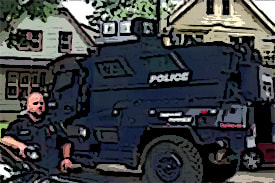

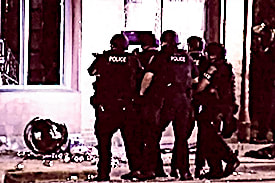


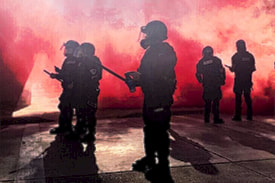


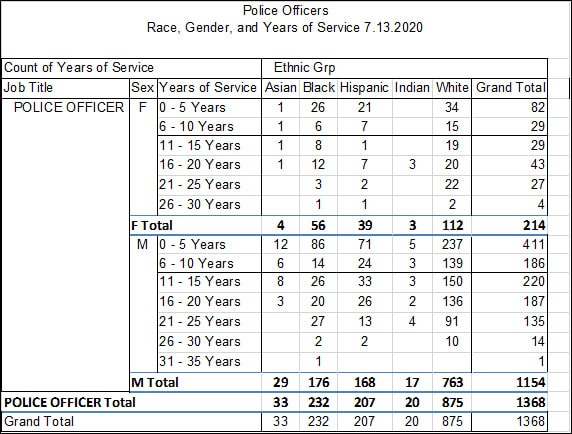

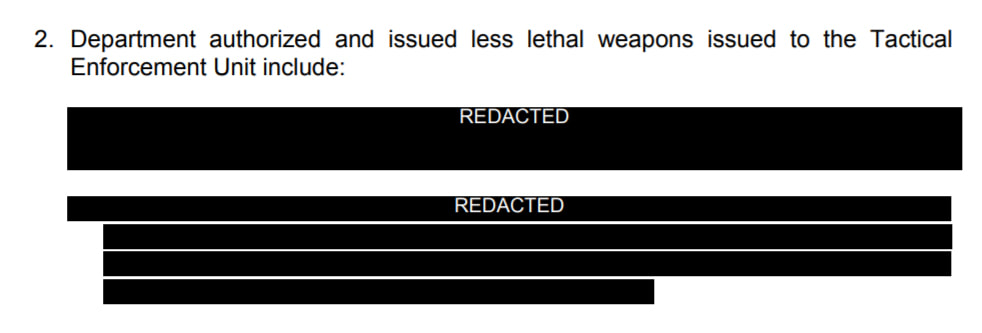
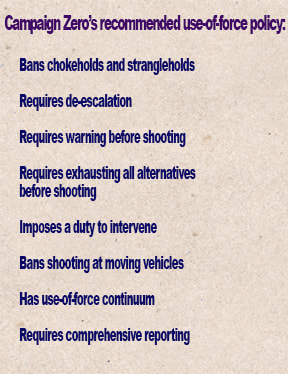
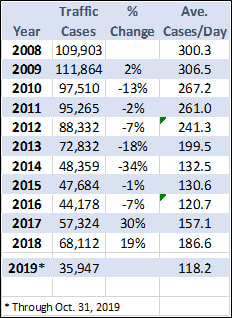
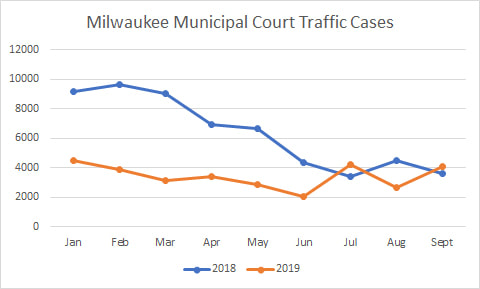
 RSS Feed
RSS Feed